Your dairy cow’s ration plays a big role in her milk production, and pasture grazing typically won’t be enough.
“Usually in grazing situations, lactating animals especially are going to be limited on energy. There’s just not enough energy concentration in what they’re consuming,” Dr. Sara Place, Oklahoma State University professor of animal science, told Ozarks Farm & Neighbor. “They’re not going to be able to eat enough in the eight or nine, maybe 10 hours a day that they’re actually going to be able to graze.”
To calculate their nutritional needs, you’ve got to know a couple of things. One of those is what they’re eating; you have to both estimate their dry matter intake and send samples of your forage to a commercial lab to get the energy value of the forage.
In addition, you have to measure their actual milk output and compare that to your target, so you can then determine how much you have to improve the ration to meet that goal.
If you continue to add supplementation to the rations, eventually you reach a point where the supplemental feed becomes the bulk of the animal’s diet. If that’s the case, Place said you should look at your pasture management.
“Even though we have a longer growing season than some farther northern places, you’re still going to have a good chunk of the year where grazing alone isn’t going to be able to provide the bulk of the animal’s diet,” she said. “If you’re in a situation where you’re providing supplement and you’re not seeing a production response, then you have to go back through the process and say, where is something essentially going wrong? Are you overpredicting how much those animals are actually consuming in terms of forage, or what the quality of that forage is?”
The quality of the milk output, measured by its components like butterfat and protein, can also be influenced by the diet.
Place said one way to enhance protein in the diet is to mix red clover or other legumes in with the grasses in the pasture; that will raise the protein in the forages to meet the animal’s needs. Because the emphasis with concentrates is with energy, they’re usually made from grains higher in carbohydrates like corn and barley, and don’t emphasize protein.
Butterfat content of milk, on the other hand, can suffer at times of the year in pasture fed herds.
Place said while confinement herds can yield higher fat percentages when they receive fermented forages like silage, “when forage is lush in terms of being fast growing in the spring, you can get into situations where you can actually get milkfat depression if they’re eating the bulk of their diet from that really fresh grass.”
The issue is one of microbiology and the rate of passage through the cow’s rumen. “You want to ensure that you have adequate fiber in your diet. That will support a healthy rumen, and as a result you will see elevated fat production in your herd,” Reagan Bluel, University of Missouri Extension dairy specialist, noted.
Bluel suggested producers consult the Nutrient Requirement of Dairy Cattle, a National Research Council (NRC) publication, for recommendations on dairy cattle nutrition. However, the current version is 15 years old, and the NRC is in the process of updating it.
“I’m a big fan of TMR, or total mixed ration, and in the TMR you can include a high-quality hay,” Bluel said. “It doesn’t have to be alfalfa, but alfalfa seems to be the ‘Queen of Forages’ and preferred by most dairymen.”
If you’re feeding TMR rations and butterfat is still depressed, she said particle size might be the culprit.
“I recommend conducting a Penn State particle separator and/or contacting your local Extension office and see if they can help you assess your TMR quality,” Bluel recommended. “If your particle size is correct to support a strong rumen mat, then perhaps it could be a function of the quality of the forage that you’re feeding. There are a couple different components, but it tends to lend itself to that forage particle length.”






